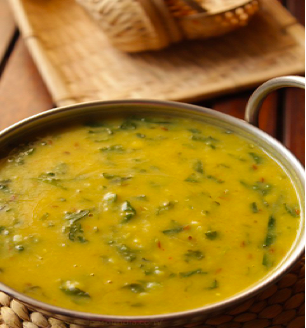Recipes for Managing Side Effects Series: Taste Changes or Metallic Taste
Changes in taste (dysgeusia) and/or metallic taste in the mouth is a common side effect experienced by individuals receiving cancer treatment [i]. Including foods with a tart taste such as citrus fruits and sorbets, fresh vegetables such as tomatoes, raw mangoes, vinegar based dressings, and pungent flavors from spices, herbs, and garlic are likely to improve the taste of food and increase appetite.
This spinach dal recipe is filled with spices, lentils and greens. Spoon it over some soft cooked rice or quinoa and enjoy it warm or at room temperature–it tastes great either way!
Nutritional Content and Health Benefits
Ingredient Highlights
- A 100 gram serving of moong dal (mung/petite yellow lentils) provides 26 grams of protein and 27 grams of fiber [ii]. Moong dal adds a mild nutty flavor and creamy texture to the dish. It is also a good source of dietary iron providing about 22% of the recommended daily value.
- Ginger aids with digestion, helps reduce pain, and has potent anti-inflammatory and antioxidant compounds to keep the body healthy [iii].
- Turmeric contains curcumin, a yellowish pigment and a well-known polyphenol with antioxidant, anti-inflammatory, anti-cancer and antidiabetic properties. Combine turmeric with piperine (the active component in black pepper) to obtain maximum bioavailability and benefit [iv].
Recipe
Spinach Dal
Serves: 4
Serving Size: ½ cup

Ingredients
- 1 cup of Moong dal
- 2 tsp of turmeric, divided
- 2 tsp olive oil or ghee, divided
- 1 tsp of cumin seeds
- 1 tsp of grated ginger
- 1 tsp of grated garlic
- ¼ tsp of asafoetida (optional)
- 1 medium tomato chopped or juice of ½ lemon
- ½ cup of raw green mango (skin peeled – optional)
- 2 cups fresh chopped spinach
- ¼ – ½ tsp of finely ground pepper
- Salt to taste
- ½ cup cooked rice or quinoa (optional)
Instructions
- Rinse the dal until the water runs clean. Soak for 15-30 mins.
- In a saucepan, add the soaked dal, 2.5 cups of water, 1 tsp of turmeric and 1 tsp of oil and bring to a boil. Cook the dal on medium-low heat, keeping the pan lid ajar or uncovered to prevent it from boiling over. Add more water as required. The dal should be cooked until soft and mushy.
- In a separate pan, heat 1 tsp of oil or ghee. Once the oil is hot, turn the heat to medium-low and add the cumin seeds. The seeds should toast slightly but not burn. Add the grated ginger, garlic and 1 tsp of turmeric and asafoetida and saute 1 minute.
- Add the tomato (if using) and saute until soft.
- Add raw mango pieces and ¼ cup of water and cover and cook until soft.
- Add the fresh spinach and saute till slightly wilted, 2-3 mins.
- Add the cooked moong dal to the pan and mix well to combine. Add water to thin out the dal to a thin pancake batter consistency.
- Add pepper and salt to taste and simmer for about 5 mins.
- Once off the heat, squeeze in ½ lemon (if not using tomato or want a tangy taste).
- Spoon over ½ cup of cooked rice, quinoa or even enjoy by itself.
Tips
- If using frozen spinach, add to the dal after it’s completely cooked and boil together to defrost and cook the spinach.
- Vegetables like soft-cooked carrots, beans and peas may also be added in at step 5 and sautéed. Finely chopped onions can be added and sautéed before adding vegetables.
- Other leafy greens like chard, mustard greens and kale may be used instead of spinach. They may require longer cooking time since they are tougher than spinach.
- Please wash all produce thoroughly before use to ensure food safety and reduce risk of infections.
For more tips on managing taste changes, check out this post.
References:
[i] Taste Changes. (2012, June 5). Cancer.net. https://www.cancer.net/coping-with-cancer/physical-emotional-and-social-effects-cancer/managing-physical-side-effects/taste-changes
[ii] Borean M, Shani K,FoodData Central. (2021). Usda.gov. https://fdc.nal.usda.gov/fdc-app.html#/food-details/445233/nutrients
[iii] Anh, N. H., Kim, S. J., Long, N. P., Min, J. E., Yoon, Y. C., Lee, E. G., Kim, M., Kim, T. J., Yang, Y. Y., Son, E. Y., Yoon, S. J., Diem, N. C., Kim, H. M., & Kwon, S. W. (2020). Ginger on Human Health: A Comprehensive Systematic Review of 109 Randomized Controlled Trials. Nutrients, 12(1), 157. https://doi.org/10.3390/nu12010157
[iv] Dei Cas, M., & Ghidoni, R. (2019). Dietary Curcumin: Correlation between Bioavailability and Health Potential. Nutrients, 11(9), 2147. https://doi.org/10.3390/nu11092147
